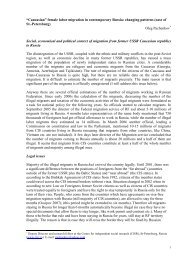THORIUM AS AN ENERGY SOURCE - Opportunities for Norway ...
THORIUM AS AN ENERGY SOURCE - Opportunities for Norway ...
THORIUM AS AN ENERGY SOURCE - Opportunities for Norway ...
Create successful ePaper yourself
Turn your PDF publications into a flip-book with our unique Google optimized e-Paper software.
The Back End of the Thorium Fuel Cycle<br />
Th/U-233 cycle waste, with the same reprocessing losses, should lead to a factor 10 lower<br />
radiotoxicity than that of the U/Pu cycle waste.<br />
To conclude, there are advantages in using thorium in thermal reactors in a once-through mode,<br />
particularly if U-233 or U-235 (HEU) can be used as topping fuel. If the burnup of thorium fuel<br />
can be extended, the waste is less radiotoxic up to 20 000 years, and perhaps more importantly,<br />
has a smaller volume compared with that from (enriched) uranium. The closed Th-cycle offers the<br />
best per<strong>for</strong>mance with respect to long-lived waste radiotoxicity compared with U/Pu scenarios, in<br />
particular if fast reactors are used.<br />
A recent study has shown that the radioactive waste from a thorium cycle will be significantly<br />
less than <strong>for</strong> the standard U/Pu cycle, in the same conditions. This is an advantage <strong>for</strong> thorium<br />
based fuels and has been confirmed in several studies; recently in the EU-supported study<br />
“Thorium as a waste management option” [138].One result of the study is illustrated in Figure 6.2<br />
where the overall radiotoxic inventories (Sv/TWhe) are compared <strong>for</strong> U/Pu and Th/U cycles as a<br />
function of elapsed time. The study is <strong>for</strong> a case where all actinides in a fast neutron reactor are<br />
recycled, assuming 0.1 % losses. It has been pointed out by Dominique Greneche et al [139] that<br />
there is a gain of a factor of 5 to 20 up to 10 000 years with thorium based fuels compared with<br />
U/Pu fuels. After about 20 000 years, the radiotoxic inventory of thorium based fuels becomes<br />
greater than that of U/Pu fuels. This is of less concern since in both cases the inventory is much<br />
lower than that of natural uranium itself. The comparison is based on the equivalent amounts of<br />
natural uranium that are needed to feed an open uranium cycle.<br />
Figure 6.2 Reduction of Radiotoxicity as a Function of Time Elapsed after Disposal of the Waste in an<br />
Inventory <strong>for</strong> the Cases of Uranium and Thorium Cycles and with Recycling of all Actinides.<br />
6.2 Thorium Cycle in Accelerator-Driven Systems<br />
Critical reactors using thorium fuel have been operated in the past, motivated by the prospect of a<br />
high neutron yield per neutron absorbed, which U-233 offers over the whole neutron energy<br />
range, only slightly surpassed by Pu-239 <strong>for</strong> fast neutrons (see Table 5.1 in Chapter 5.2 <strong>for</strong><br />
details). However, there is an associated disadvantage in breeding U-233: i.e. the production of<br />
Pa-233, which has a large neutron capture cross-section, and which must be compensated <strong>for</strong> by a<br />
73

















